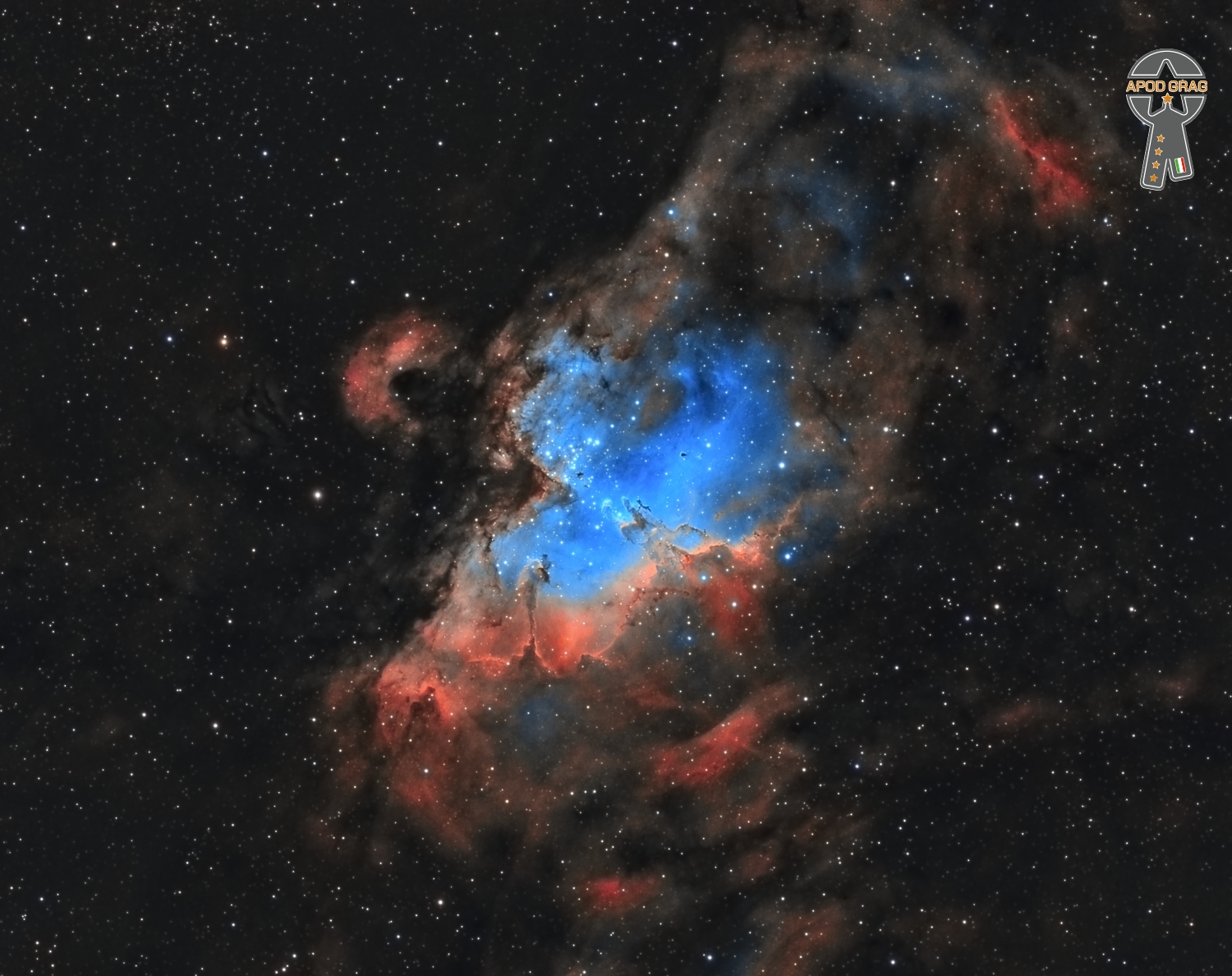Blog
Performing for Yom Kippur Service today at 4pm at Mt Zion Temple in St Paul
more...On the left, bright emission outlined by dark, obscuring dust lanes seems to trace a continental shape, lending the popular nameNorth America Nebula to the emission region cataloged as NGC 7000. To the right, just off the North America Nebula’s east coast, is IC 5070, whose avian profile suggests the Pelican Nebula. The two bright nebulae are about 1,500 light-years away, part of the same large and complex star forming region, almost as nearby as the better-known Orion Nebula. At that distance, the 3 degree wide field of view would span 80 light-years. This careful cosmic portrait uses narrow band images combined to highlight the bright ionization fronts and the characteristic glow from atomic hydrogen, sulfur, and oxygen gas. These nebulae can be seen with binoculars from a dark location. Look northeast of bright star Deneb in the constellation Cygnus the Swan.

Earl Klugh (/kluː/ KLOO; born September 16, 1953) is an American acoustic guitarist and composer. He has won one Grammy award and thirteen nominations. Klugh was awarded the “1977” Best Recording Award For Performance and Sound” for his album “Finger Painting” by “Swing Journal” a Japanese jazz magazine.
At the age of six, Klugh commenced training on the piano until he switched to the guitar at the age of ten. At the age of thirteen, Klugh was captivated by the guitar playing of Chet Atkins when Atkins made an appearance on the Perry Como Show. Klugh was a performing guest on several of Atkins’ albums. Atkins, reciprocating as well, joined Earl on his Magic In Your Eyes album. Klugh also appeared with Atkins on several television programs, including Hee Haw and a 1994 TV special entitled “Read my Licks”. Klugh was also influenced by Bob James, Ray Parker Jr, Wes Montgomery and Laurindo Almeida. His sound is a blend of these jazz, pop and rhythm and blues influences, forming a potpourri of sweet contemporary music original to only him.
more...Charlie Lee Byrd (September 16, 1925 – December 2, 1999) was an American jazz guitarist. Byrd was best known for his association with Brazilian music, especially bossa nova. In 1962, he collaborated with Stan Getz on the album Jazz Samba, a recording which brought bossa nova into the mainstream of North American music.
Byrd played fingerstyle on a classical guitar.
Charlie Byrd was born in 1925 in Suffolk, Virginia, and grew up in the borough of Chuckatuck. His father, a mandolinist and guitarist, taught him how to play the acoustic steel guitar at age 10. Byrd had three brothers, Oscar, Jack, and Gene “Joe” Byrd, who was a bass player. In 1942, Byrd entered the Virginia Polytechnic Institute and played in the school orchestra. In 1943, he was drafted into the United States Army for World War II, saw combat, then was stationed in Paris in 1945 where he played in an Army Special Services band and toured occupied Europe in the all-soldier production G.I. Carmen.
After the war, Byrd returned to the United States and studied composition and jazz theory at the Harnett National Music School in Manhattan, New York City. During this time, he began playing a classical guitar. After moving to Washington, D.C. in 1950, he studied classical guitar with Sophocles Papas for several years. In 1954, he became a pupil of the Spanish classical guitarist Andrés Segovia and spent time studying in Italy with Segovia.
Byrd’s earliest and greatest influence was the gypsy guitarist Django Reinhardt, whom he saw perform in Paris.
more...Riley B. King (September 16, 1925 – May 14, 2015 Berclaire, MS), known professionally as B.B. King, was an American blues singer-songwriter, guitarist, and record producer. He introduced a sophisticated style of soloing based on fluid string bending, shimmering vibrato and staccato picking that influenced many later blues electric guitar players. AllMusic recognized King as “the single most important electric guitarist of the last half of the 20th century”.
King was inducted into the Rock and Roll Hall of Fame in 1987, and is one of the most influential blues musicians of all time, earning the nickname“The King of the Blues”, and is considered one of the “Three Kings of the Blues Guitar” (along with Albert King and Freddie King, none of whom are blood related). King performed tirelessly throughout his musical career, appearing on average at more than 200 concerts per year into his 70s. In 1956 alone, he appeared at 342 shows.
King was born on a cotton plantation in Itta Bena, Mississippi, and later worked at a cotton gin in Indianola, Mississippi. He was attracted to music and the guitar in church, and began his career in juke joints and local radio. He later lived in Memphis, Tennessee and Chicago, and as his fame grew, toured the world extensively. King died at the age of 89 in Las Vegas, Nevada, on May 14, 2015.
more...8th is a series of 9 Drumming Workshops at the MN VA Adult Day Center for the Memory Loss Unit. Arming my soldiers with rhythms of celebration and harmony. Wednesday September 15th 2021 10am-noon.
more...
The Eagle Nebula (catalogued as Messier 16 or M16, and as NGC 6611, and also known as the Star Queen Nebula and The Spire) is a young open cluster of stars in the constellation Serpens, discovered by Jean-Philippe de Cheseaux in 1745–46. Both the “Eagle” and the “Star Queen” refer to visual impressions of the dark silhouette near the center of the nebula, an area made famous as the “Pillars of Creation” imaged by the Hubble Space Telescope. The nebula contains several active star-forming gas and dust regions, including the aforementioned Pillars of Creation. The Eagle Nebula lies in the Sagittarius Arm of the Milky Way.
Julian Edwin “Cannonball” Adderley (September 15, 1928 – August 8, 1975) was an American jazz alto saxophonist of the hard bop era of the 1950s and 1960s.
Adderley is perhaps best remembered for the 1966 soul jazz single “Mercy, Mercy, Mercy“, which was written for him by his keyboardist Joe Zawinuland became a major crossover hit on the pop charts. A cover version by the Buckinghams also reached #5 on the charts. Adderley worked with Miles Davis, first as a member of the Davis sextet, appearing on the seminal records Milestones (1958) and Kind of Blue (1959), and then on his own 1958 album Somethin’ Else. He was the elder brother of jazz trumpeter Nat Adderley, who was a longtime member of his band.
Originally from Tampa, Florida, his nickname derived from “cannibal”, a title imposed on him by high-school colleagues as a tribute to his voracious appetite. Cannonball moved to Tallahassee when his parents obtained teaching positions at Florida A&M University. Both Cannonball and brother Nat played with Ray Charles when Charles lived in Tallahassee during the early 1940s. Adderley moved to Broward County, Florida, in 1948 after finishing his music studies at Florida A&M and became the band director at Dillard High School in Fort Lauderdale, a position which he held until 1950.
Cannonball left Southeast Florida and moved to New York in 1955. One of his known addresses in New York was in the neighborhood of Corona, Queens. He left Florida originally to seek graduate studies at New York conservatories, but one night in 1955 he brought his saxophone with him to the Café Bohemia. Cannonball was asked to sit in with Oscar Pettiford in place of his band’s regular saxophonist, who was late for the gig. The “buzz” on the New York jazz scene after Adderley’s performance announced him as the heir to the mantle of Charlie Parker.
more...Albert Aloysius Casey (September 15, 1915 – September 11, 2005), known professionally as Al Casey, was an American jazz guitarist who was a member of Fats Waller‘s band during the 1930s and early 1940s.
Casey was born in Louisville, Kentucky. He attended DeWitt Clinton High School in New York City and studied guitar.
He was a child prodigy who first played violin, then switched to ukulele. He began playing guitar in 1930 and met Fats Waller in 1933. The following year, at the age of eighteen, he became a member of Waller’s band, making many recordings with the band, and he is known for having played the solo in “Buck Jumpin'”. After Waller’s death in 1943, he led his own trio. For two consecutive years in the 1940s, he was voted best guitarist in Esquiremagazine.
more...Arvell Shaw (September 15, 1923 – December 5, 2002) was an American jazz double-bassist, best known for his work with Louis Armstrong.
He was born in St. Louis, Missouri, United States. Shaw learned to play tuba in high school, but switched to bass soon after. In 1942 he worked with Fate Marable on riverboats traveling on the Mississippi River, then served in the Navy from 1942 to 1945. After his discharge he played with Armstrong in his last big band, from 1945 to 1947. Shaw and Sid Catlett then joined the Louis Armstrong All-Stars until 1950, when Shaw broke off to study music. He returned to play with Armstrong from 1952 to 1956, and performed in the 1956 musical, High Society.
more...Roy Claxton Acuff (September 15, 1903 – November 23, 1992) was an American country music singer, fiddler, promoter, and freemason. Known as the “King of Country Music”, Acuff is often credited with moving the genre from its early string band and “hoedown” format to the singer-based format that helped make it internationally successful. In 1952, Hank Williams told Ralph Gleason, “He’s the biggest singer this music ever knew. You booked him and you didn’t worry about crowds. For drawing power in the South, it was Roy Acuff, then God.”
Acuff began his music career in the 1930s and gained regional fame as the singer and fiddler for his group, the Smoky Mountain Boys. He joined the Grand Ole Opry in 1938, and although his popularity as a musician waned in the late 1940s, he remained one of the Opry’s key figures and promoters for nearly four decades. In 1942, Acuff and Fred Rose founded Acuff-Rose Music, the first major Nashville-based country music publishing company, which signed such artists as Hank Williams, Roy Orbison, and the Everly Brothers. In 1962, Acuff became the first living inductee into the Country Music Hall of Fame.
Acuff was born on September 15, 1903 in Maynardville, Tennessee, to Ida (née Carr) and Simon E. Neill Acuff, the third of their five children. Roy Acuff is of Scottish ancestry, and his ancestors came to North America during the colonial era, settling in the mountains of Virginia and the Carolinas. The Acuffs were a fairly prominent family in Union County. Roy’s paternal grandfather, Coram Acuff, had been a Tennessee state senator, and his maternal grandfather was a local physician. Roy’s father was an accomplished fiddler and a Baptist preacher, his mother was proficient on the piano, and during Roy’s early years the Acuff house was a popular place for local gatherings. At such gatherings, Roy would often amuse people by balancing farm tools on his chin. He also learned to play the harmonica and jaw harp at an early age.
more...https://www.youtube.com/watch?v=xXssKGJLdf8&list=PLEB3LPVcGcWbHKyo-uy8CkVvebHEsluVK&index=53
more...The Andromeda Galaxy, also known as Messier 31, M31, or NGC 224 and originally the Andromeda Nebula, is a barred spiral galaxy approximately 2.5 million light-years from Earth and the nearest large galaxy to the Milky Way.
Setup :
– Skywatcher EQM 35 mount driven via EQMOD in NINA
– TS 71 SDQ scope (focal length 450mm)
– ZWO Asi 2600 MC camera (cooled to -10°C, gain 100 and offset 50)
– Siril + PixInsight + Photoshop
Exifs :
– 60 x 300s in RGB with IDAS P3 anti-PIL filter
– 30 x 600s with L-extrem filter
– 20 DOF
– Sky Bortle 5 (Avril, Grand Est, France)

Frederick Dewey Smith (September 14, 1948 – November 4, 1994), known professionally as Fred “Sonic” Smith, was an American guitarist, best known as a member of the influential and political Detroit rock band MC5.At age 31, he married and raised a family with poet and fellow rock musician Patti Smith. The couple collaborated musically, and raised two children together.
Smith was a guitarist with the MC5 and later went on to form Sonic’s Rendezvous Band, which released one single, “City Slang”, during Smith’s lifetime. In 1988 he collaborated with Patti Smithon her album Dream of Life.
In 2018, Smith was inducted into the West Virginia Music Hall of Fame alongside Hasil Adkins and Ann Magnuson. A resident of St. Clair Shores, Michigan (a Detroit suburb), Fred Smith died in Detroit in 1994. He had been in poor health for years and succumbed to heart failure.
more...Oliver Lake (born September 14, 1942) is an American jazz saxophonist, flutist, composer, poet, and visual artist. He is known mainly for alto saxophone, but he also performs on soprano and flute. During the 1960s, Lake worked with the Black Artists Group in St. Louis. In 1977, he founded the World Saxophone Quartet with David Murray, Julius Hemphill, and Hamiet Bluiett. He has worked in the group Trio 3 with Reggie Workman and Andrew Cyrille. He has appeared on more than 80 albums as a bandleader, co-leader, and side musician. He is the father of drummer Gene Lake. Lake has been a resident of Montclair, New Jersey.
more...Joseph Jarman (September 14, 1937 – January 9, 2019) was an American jazz musician, composer, poet, and Shinshu Buddhist priest. He was one of the first members of the Association for the Advancement of Creative Musicians and a member of the Art Ensemble of Chicago.
He was born in Pine Bluff, Arkansas, United States. Jarman grew up in Chicago, Illinois. At DuSable High School, he studied drums with Walter Dyett, switching to saxophone and clarinet when he joined the United States Army after graduation. During his time there, he was part of the 11th Airborne Division Band for a year.
more...More Posts
- Flamenco Fridays Estrella Morente
- Daily Roots Alton Ellis
- Rhythm Roots Workshop Ecumen North Branch Senior Living
- Cosmos NGC 3372
- Richie Furay
- Sonny Curtis
- Tania Maria
- Nokie Edwards
- Dennis Chambers
- World Drumming Trinidad & Tobago
- Daily Roots Dennis Brown
- Rhythm Roots Workshop Residency Ecumen Lakeview Commons Assisted Living
- Cosmos Trumpler 16
- Mahmoud Ahmed
- Keith Jarrett
- Mary Lou Williams
- Robert Johnson
- World Drumming Baba Ayo Adeyemi
- Daily Roots Prince Far I & The Arabs
- Cosmos NGC 253